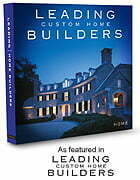Life and work styles are evolving. Make sure the home office is up to date.
It’s not news that home offices have become mainstream. According to a recent Forbes study, one in five Americans work from home, and that number continues to rise. Technology has made working from home efficient and convenient. The home office now appears in homes of every type, size, style and price range.
Builders have traditionally placed the home office on the main floor. A favorite location is just inside the front door, with enough separation from the main living area to give the worker some privacy.
The advantage to working with a custom builder is that the homeowners can design an office that’s tailored to their specific needs. To do it right, the homeowners need to carefully consider how they like to work, and how they will use the space.
Today’s homeowners have more computing mobility than they did five or ten years ago, thanks to the near ubiquity of wireless internet. Even someone with a desktop computer and a 48-inch monitor will likely have a laptop, tablet or smart phone, and may prefer to do much of his or her work at the kitchen table or out on the patio. This has led some homeowners, and even some designers, to question whether the home office still makes sense.
For most people the answer is yes. It just may be different than the office of just five years ago.
For example, consider the freelance writer who prefers to roam the house, laptop in hand. He or she will still need a place to plug in the printer and store papers and office supplies to keep clutter contained. Also, the kids with their laptops and tablets need a central space to print papers and projects for school. A small desk and chair can be added for work that needs to be done in private. These spaces can be smaller than traditional offices—in fact, some designers have noted a trend toward pocket offices in convenient locations, such as next to the master bedroom or kitchen.
Of course, some people will still need a full-sized workspace with the basics of any good office: ample surfaces, bookshelves and file cabinets, and task lighting. Exact requirements will vary by client—an artist may need a lot of counter space while an accountant who meets with clients at home may need a separate entrance, a small conference table, and a shared powder room. Depending on budget and available floor space, some people may want room for personal touches, such as a sofa or a piece of exercise equipment. And of course anyone doing serious work while the family is home will want good sound insulation between the office and the main house.
Another thing to consider is if data wiring (sometimes called “structured wiring”) is necessary despite the availability of wireless connections. Wireless is convenient, but when TV’s, games, computers, and security systems are all competing for bandwith, a wireless router can’t match the speed, stability, and security of a hardwired network. This allows someone to work from a home office and not get bogged down when kids are doing homework and watching television.
By thinking through their needs in partnership with a good professional builder, the homeowners can design an office space that’s a perfect match for their home, their lifestyle, and their budget.
Make it a great day!


David Baud CGR, CGB, CGP
Baud Builders, Inc.
PO Box 5708
Wakefield, RI 02880
(401) 789-1176 – Phone
(401) 789-2258 – Fax
david@baudbuilders.com
www.baudbuilders.com
July 2014
Copyright 2014. All rights reserved.









